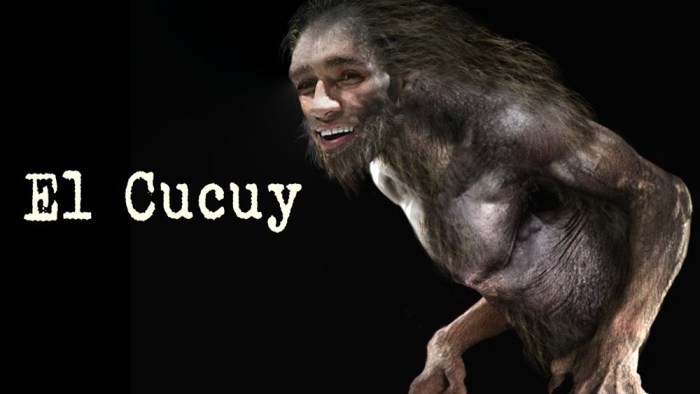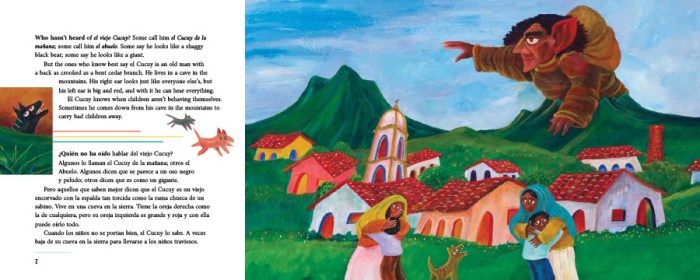El cucuy story in spanish – El Cucuy, the boogeyman of Spanish folklore, has captivated and terrified generations of children and adults alike. Its origins and cultural significance have shaped its role in traditional folklore and mythology, and modern adaptations have reinterpreted the character in contemporary culture.
This enigmatic figure, often depicted as a shadowy creature with glowing eyes, has been used to educate and discipline children, instilling a sense of fear and caution. The psychological and cultural impact of the El Cucuy story continues to resonate, making it a fascinating subject of exploration.
El Cucuy

El Cucuy, a prevalent figure in Spanish-speaking folklore, is a boogeyman-like entity that serves as a cautionary tale for disobedient children. The origins of El Cucuy can be traced back to pre-Columbian times, with variations of the story existing across different regions and cultures.
Variations and Interpretations
In some regions, El Cucuy is depicted as a shadowy figure with glowing red eyes, sharp claws, and a grotesque appearance. In other interpretations, it is believed to be a malevolent spirit that haunts the darkness, preying on those who venture out alone at night.
The specific characteristics and powers attributed to El Cucuy vary depending on the region and the storyteller’s imagination.
The Role of El Cucuy in Folklore and Mythology

El Cucuy, a legendary figure in Spanish folklore, has played a significant role in shaping cultural beliefs and practices for centuries. In traditional Spanish folklore, El Cucuy is often depicted as a malevolent spirit or monster that lurks in the shadows, preying on disobedient children.
The figure is said to have a fearsome appearance, with glowing red eyes, sharp claws, and a menacing grin.
El Cucuy as a Tool for Discipline and Education
El Cucuy has been a widely used figure in Spanish-speaking households as a means of instilling discipline and obedience in children. Parents and elders would often threaten misbehaving children with the consequences of El Cucuy’s wrath. Stories of the monster’s gruesome punishments for disobedience, such as carrying children away in a sack or devouring them whole, served as a potent deterrent against bad behavior.Over
time, the El Cucuy story has evolved into a cautionary tale that teaches children the importance of listening to their elders and respecting authority. It has also been used to encourage children to behave well in public settings, such as by avoiding strangers or staying close to their parents.
El cucuy, the mythical creature of Spanish folklore, is said to lurk in the shadows, instilling fear in the hearts of naughty children. Its tale is often told to keep them in line. In a similar vein, the iconic “I pity the fool” speaker, whose memorable catchphrase has left an indelible mark , also evokes a sense of amusement and pity towards those who fall victim to their own folly.
Just as el cucuy serves as a cautionary figure for children, the “I pity the fool” speaker reminds us of the consequences of reckless actions.
Modern Adaptations and Interpretations

In contemporary culture, El Cucuy has undergone a series of adaptations and reinterpretations, reflecting the evolving nature of folklore and mythology in modern society.
In literature, El Cucuy has emerged as a recurring character in horror and suspense stories. Writers have explored the character’s sinister nature, depicting it as a malevolent entity that preys on children and instills fear in adults. Notable examples include Stephen King’s short story “The Boogeyman” and Guillermo del Toro’s novel “The Devil’s Backbone.”
Film and Television Adaptations, El cucuy story in spanish
Film and television have also played a significant role in shaping the modern perception of El Cucuy. Horror films like “The Babadook” (2014) and “Sinister” (2012) have featured characters inspired by the folklore, often portraying them as menacing and terrifying creatures.
In the television series “Supernatural,” El Cucuy is depicted as a powerful demon with a predilection for children.
Cultural Symbolism and Reinterpretation
Beyond its role in horror and suspense, El Cucuy has also become a cultural symbol in contemporary society. In some contexts, it is used as a metaphor for the unknown or the dangers lurking in the shadows. Artists and musicians have drawn inspiration from the character, incorporating it into their work to evoke feelings of fear, mystery, and the supernatural.
Psychological and Cultural Impact: El Cucuy Story In Spanish

The story of El Cucuy has a profound psychological impact on children and adults. For children, it serves as a powerful deterrent against misbehavior, as they fear the consequences of encountering the fearsome creature. Adults, on the other hand, may experience a sense of nostalgia or unease when recalling their childhood encounters with the myth.
Cultural Significance
El Cucuy is a deeply rooted cultural symbol of fear and the unknown in Latin American folklore. Its presence in stories, legends, and popular culture reflects the cultural anxiety surrounding the dangers that lurk in the shadows. The creature’s elusive and enigmatic nature adds to its power, making it a potent embodiment of the fears that haunt the human psyche.
FAQ
What is the origin of El Cucuy?
El Cucuy originated in Spanish-speaking countries as a mythical creature used to scare children into behaving.
How does the El Cucuy story vary across different regions?
The El Cucuy story varies in appearance, behavior, and origin depending on the region, with some portraying it as a shadowy figure, while others depict it as a humanoid creature.
What is the role of El Cucuy in modern culture?
El Cucuy has been featured in modern literature, film, and other media, often as a symbol of fear or the unknown, but also as a source of inspiration and cultural pride.
